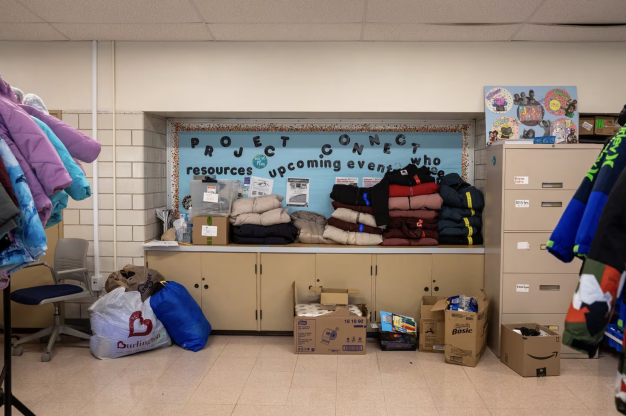
As families struggle to find housing, more schools are hiring staff to help. The clock is ticking
It was late September when Latoya Singley got the eviction notice saying she and her six-year-old had seven days to clear out of their apartment.
Singley called Cincinnati’s shelter hotline repeatedly for weeks, but there were no beds available. Singley and her son couldn’t stay long with Singley’s sister, because having guests would jeopardize her sister’s subsidized housing.
Singley worried about her son, who’s autistic and needs specialised support. “It would be different if it was just me,” Singley said. “But I have a child – I can’t be outside.”
Her frequent calls to the hotline yielded results. An intake worker referred Singley’s case to Megan Rahill, a shelter and housing specialist for Cincinnati Public Schools. Rahill flagged the family with a bright orange “EXTREMELY HIGH” priority label and pushed them to the top of shelter waitlists. Just in time, space opened up at Bethany House, the city’s main family shelter, says Kalyn Belsha of Chalkbeat.
“It changed so much for us,” Singley said in early December. They felt safe, instead of scared. Her son enrolled in an elementary school where Singley liked the teachers and therapists. And she landed an appointment to check out a two-bedroom apartment.
Rahill is part of a growing contingent of school staffers whose primary job is to help students and their families navigate housing systems. Many districts have used their share of an unprecedented $800 million in COVID relief funding for homeless students to shrink gaping holes in the social safety net, providing services that didn’t used to be schools’ responsibilities.
‘It changed so much for us’
Schools have leaned into this type of work in part because research shows housing instability affects everything from attendance to test scores to graduation rates.
Project Connect, Cincinnati Public Schools’ program that supports students and families experiencing homelessness, used to provide mostly educational support. Now, with $1.5 million in COVID aid and more staff, Project Connect ensures fewer families have to sort through a complex web of housing and social service agencies alone.
Against a rising tide of family homelessness, Cincinnati’s housing systems navigators are on track to provide help to twice as many students this school year as last year.
But the looming expiration of pandemic funding means this help could be going away. Rahill’s shelter and housing position, for example, is only funded through June.
:quality(85)/cloudfront-us-east-1.images.arcpublishing.com/civicnewscompany/I2Z4QKGLAJGVHM35R36XF5G6J4.JPG)
“We won’t have the staff, we won’t have the same level of services — unless we find some miracle funding,” said Rebeka Beach, who manages Project Connect.
How housing systems navigators help homeless students
The idea of hiring a navigator started in the health care industry in the 1990s. The American Cancer Society was an early pioneer, deploying navigators who helped patients get screenings, treatment, and family support.
Schools picked up the model at the urging of federal education officials and advocates for homeless youth, who said it made sense for schools because staff were already in contact with families, and often had their trust.
Having a person who specializes in housing has allowed the Cincinnati school district to form closer relationships with local shelters and housing agencies, Rahill said. That’s helped families with kids get priority access to a limited supply of shelter beds and housing vouchers.
When Rahill was a homeless student liaison supporting 20 Cincinnati elementary schools, she often wished she could do more for families. Parents would tell her, “OK, thank you for the uniforms and transportation, but can you refer me for housing?” she said.
Rahill’s work means more families get help faster. So far this school year, she’s referred 522 children and teens to a shelter, a housing voucher, or another kind of housing support. That’s nearly as many as the district helped all of last school year.
That extra help is coming as student homelessness in Cincinnati is rising. Project Connect has identified nearly 2,700 children and teens as homeless so far this year, an increase of more than 20% compared with this time last year.
School staff say there’s a few reasons for that. The average stay at the main family shelter has stretched to over two months as families struggle to find housing. That creates longer waitlists. Rent has risen in Cincinnati much faster than in other cities, and evictions are up, following the end of pandemic-era protections. And families lucky enough to obtain a housing choice voucher are finding it increasingly difficult to find landlords who will accept the rental subsidy.
Rahill sees how that housing crunch has affected families.
On a Friday in early December, she spoke on the phone with the mother of five elementary-age children who had a month to leave their home of six years. Their heat was broken and a city inspection turned up faulty wiring — a “death trap,” the mother had been told. The landlord wasn’t returning her calls. As the stress mounted, she could tell it was affecting one of her children’s behavior at school.
Rahill made sure the parent knew about her rights to relocation assistance, and shared a list of apartments that may accept housing vouchers. Then she offered to refer her to an agency that could help pay for a security deposit and first month’s rent — a step the mother had tried on her own without success.
“If it comes through me, then you are more likely to hear from them,” Rahill explained. She urged the mother to hang on to her number: “We would definitely make sure that you guys weren’t out on the street.”
Before she hung up, Rahill had one more thing to say. “You were mentioning that you guys weren’t going to be able to have Christmas,” she began. The district was hosting a toy drive, but was at capacity. “Do you mind if I put you on the waiting list and I’ll give you a call if we have leftover toys?”
Later that Friday, Rahill got a message from another mother who was sleeping in her car with her four kids, including a preschooler. She’d applied for a housing voucher with the district’s help, but hadn’t heard back from the housing authority yet.
“I’m really desperate at this point,” the mother said in her voicemail. “I just need somewhere for me and my kids to go.” Rahill caught her breath as she listened, then dialed the parent’s number. She offered to make a priority shelter referral that would expedite the process. After she hung up, she highlighted the family in bright orange. Extremely high priority.
Schools can’t clear all the housing hurdles
As part of her work, Rahill made a 10-page guide for families. It has everything from how to apply for a housing voucher to where kids can get a free haircut. She knows a kennel that is willing to take a pet so that a family can move into shelter. And her shelter connections stretch to Indiana.
When the local shelters are full, Rahill can book families a few free nights at a local Quality Inn using COVID relief funds. The hotel owners charge Project Connect a discounted $75 a night, and sometimes extend that rate to families so they can stay longer.
“Our community needs help, and if we can’t step up, who will?” said co-owner Kevin Patel.
But Rahill can’t solve all problems. Perhaps most importantly, Project Connect is still limited by a dearth of affordable housing – a problem that plagues communities nationwide.
Rahill can usually only get families into a shelter when they are sleeping outside or in their car. Yet that situation has become more common in recent months.
Many immigrant families, especially newly arrived families from Venezuela and Nicaragua, don’t qualify for widely used public programs. And without Spanish-speaking case workers, they struggled to access the help that was available.
To address that gap, Project Connect used COVID aid to hire Charity Tyne to work part time with Spanish-speaking families. Before Tyne, Project Connect used interpretation services or Google Translate, but that often failed to detect when families were in need.
“There have been many instances where someone has called a family and has said: ‘Are you OK with housing?’ And they’ll be like ‘Yes, yes.’” Tyne said. “And then if they’re called by someone who speaks Spanish you hear the whole story.”
Because many immigrant families don’t qualify for benefits, Tyne orders them groceries and delivers them herself. She has built up a list of landlords who charge low rents and are willing to be flexible on rental history and employment.
It’s labour-intensive work. Recently, it took Tyne 50 calls to help one family with four children rent an apartment. More than 100 Spanish-speaking families have Tyne’s cell phone number now.
‘There should be more of a safety net’
As schools across the country have expanded their work to meet students’ basic needs — from providing food to shelter to mental health care – one downside is that families and outside organisations may think schools have the ability to do more than they can.
Rahill distributes housing voucher applications from Cincinnati’s housing authority to families who don’t have a stable mailing address. Now, some parents call Rahill frustrated, mistakenly believing she — and not the housing authority – is processing their application.
“It just shows the gap,” she said. “There should be more of a safety net around people that’s not just some COVID funding through the school district.”
Many school districts, like Cincinnati, are weighing whether they can afford to keep the staff they hired with one-time COVID relief, said Marguerite Roza, the director of the Edunomics Lab, a research center at Georgetown University that studies school finance.
“That’s the tricky question,” she said. “Are we saying, basically, that when the housing system is supposed to meet the needs of kids first, it’s up to the school system to hold their feet to the fire?”
Some educators say housing and education are too closely linked for schools to just sit back and let someone else handle it.
When Cincinnati teacher Clarice Williams tutors kids in the evenings at Bethany House through Project Connect, she often meets students who have attended three or four elementary schools. Others missed large chunks of school.
She’s seen elementary students struggle to understand what they’re reading because they’re sounding out words so slowly, and middle schoolers who never learned crucial grammar and spelling rules. “They are missing those foundational skills,” she said.
‘They are missing those foundational skills’
If schools see this work as critical, Roza said, then they have to figure out how to make it sustainable, possibly by training other existing staff to do the work. Beach has been talking with a county agency and other organisations to see if there is a way to cobble together ongoing funding for the housing and shelter position.
For some families, like the mother and son who faced an eviction in September, a shelter stay is a bridge to permanent housing. On a Friday in mid-December, Singley watched as her 6-year-old explored the apartment she’d just leased.
After several weeks of sleeping on an unfamiliar bunk bed at the shelter, her son had his own bedroom again. Already, Singley could see where she’d hang posters on his wall and PAW Patrol curtains in his window.
Her son is set to start at his new school after winter break. Singley feels confident about the plan they’ve put together for him, with one-on-one help in his classroom and time with a speech therapist. He’s started to learn a few words: no, shoe, and “eat eat.”
There was just one thing left to do: Call the school district to let them know they’d found an apartment, so they could send the bus.
This story was originally published by Chalkbeat, a non-profit news site covering educational change in public schools. Sign up for their newsletters at ckbe.at/newsletters. This story was produced with support from the Education Writers Association Reporting Fellowship program.
Kalyn Belsha is a senior national education reporter based in Chicago. Contact her at kbelsha@chalkbeat.org.




